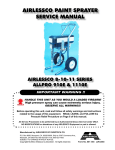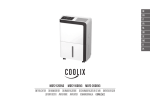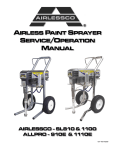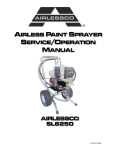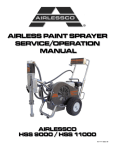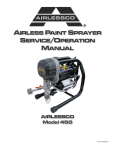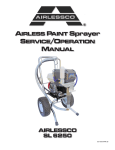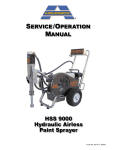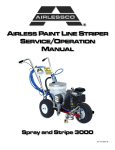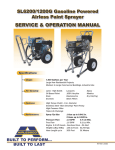Download AIRLESSCO SL810 Specifications
Transcript
INTRODUCTION This airless paint sprayer is a time tested, slow stroking pump - contractor approved to meet the demanding needs of the professional painting contractor. SPECIFICATIONS AIRLESSCO ALLPRO GPM PRESSURE MAX. TIP SIZE 8 SERIES SL810 810E .81 3000 .021 (1 gun)- .017 (2 guns) 10/11 SERIES SL1100 1000E 1.1 3000 .033(1 gun)- .021 (2 guns) WARNING Prior to starting, read, understand and observe all safety precautions & warnings on page 4, 5, 6 & 7 and all labels and tags on the machine. FLUSHING - Read prior to using your sprayer 1. New Sprayer Your new unit was factory tested in oil, which was left in the pump. Before using oil-base paint , flush with mineral spririts only. Before using water-base paint , flush with mineral spirits, followed by soapy water, then a clean water flush. 2. Changing Colors Flush with a compatible solvent such as mineral spirits or water. 3. Changing From Water-base to Oil-base Flush with soapy water, then mineral spirits. 4. Changing From Oil-base to Water-base Flush with mineral spirits, followed by soapy water, then a clean water flush. 5. Storage Always relieve pressure (See pressure relief procedure on page 6) prior to storage or when machine is unattended. Oil-base Paint: Flush with mineral spirits. Ensure that there is no pressure in the unit, then close the prime/ pressure relief valve. Water-base Paint: Flush with water, then mineral spirits. For longer term storage use a 50/50 mixture of mineral spirits and motor oil. Always ensure that there is no pressure in the unit, and close the prime/pressure relief valve for storage. WARNING: NEVER LEAVE PUMP UNATTENDED WHILE UNDER PRESSURE ! 6. Start Up After Storage Before using water-base paint, flush with soapy water and then a clean water flush. When using oil-base paint, flush out the mineral spirits with the material to be sprayed. 1 HOW TO FLUSH FIG. 1 REMOVE SPRAY TIP FIG. 3 ENGAGE GUN SAFETY LATCH (LOCK GUN) as per gun instruction manual. metal pail FIG. 2 Pressure Control Knob: used to adjust pressure only. Turn clockwise to increase pressure and counterclockwise to decrease pressure. On/Off Switch Thermal Overload Switch Prime/Pressure Relief Valve (Prime/PR Valve) Used to relieve pressure from gun, hose & tip and to prime the unit when in OPEN position. (It is in open position when there is a wider gap between valve handle and cam body) When in CLOSED position, there is only a very slight gap between handle & body. When closed the system is pressurized. Handle as a loaded firearm! 1. Be sure the gun safety latch is engaged and there is no spray tip in the gun. Refer to your separate instruction manual provided with your gun on its safety features and how to engage safety latch. Refer to Fig. 1 8. Disengage the gun safety latch and squeeze the gun trigger. At the same time, slowly turn the pressure control knob clockwise, just enough to start the pump. Refer to Fig. 2. 2. Pour enough clean, compatible solvent into a large, empty metal pail to fill the pump and hoses. 9. Allow the pump to operate until clean solvent comes from the gun. 3. Place the suction tube into the pail or place the pail under the pump. 10. Release the trigger and engage the gun safety latch. 4. Turn the pressure control knob to low pressure. Refer to Fig. 2. 5. Open the prime valve to the open- priming position. This will allow an easy start. Refer to Fig. 2. 6. Turn the motor ON/OFF switch to ON. 7. Point the gun into the metal pail and hold a metal part of the gun firmly against the pail. Refer to Fig. 3. WARNING: To reduce the risk of static sparking, which can cause fire or explosion, always hold a metal part of the gun firmly against the metal pail when flushing. This also reduces splashing. Refer to Fig. 3. 2 11. If you are going to start spraying, place the suction tube into the supply container. Release the gun safety latch and trigger the gun into another empty , metal container, holding a metal part of the gun firmly against the metal pail, and force the solvent from the pump and hose. Engage the gun safety latch until you are ready to prime the pump. 12. If you are going to store the sprayer , remove the suction tube from the solvent pail, holding a metal part of the gun firmly against the metal pail, force the solvent from the pump and hose, Engage the gun safety latch. Refer to "Storage" procedure on page 1. 13. Whenever you shut off the sprayer follow the Pressure Relief Procedure Warning on Page 6. SETTING UP 1. Connect the Hose and Gun 3. Check the Electrical Service a. Remove the plastic cap plug from the outlet connector and screw a conductive or grounded 3000 psi spray hose onto fluid outlet. Be sure the electrical service is 120 V, 60 HZ AC 15 amp minimum and that the outlet you use is properly grounded. b. Connect an airless spray gun to the other end of the hose. 4. Grounding 2. Fill the Packing Nut/Wet Cup 1/3 full with Throat Seal Oil (TSO) supplied. (Fig. 4) FIG. 4 WARNING: To reduce the risk of static sparking, fire or explosion which can result in serious bodily injury and property damage, always ground the sprayer and system components and the object being sprayed as instructed on page 6. 5. Flush the sprayer as per "Flushing" - New Sprayer on page 1 and "How to Flush" on page 2. SETTING UP AND STARTING 1. Learn the Controls Read Safety Warnings on page 4, 5, 6 and 7 before starting. FIG. 5 Pressure Control Knob -used to adjust pressure only. Turn clockwise to increase pressure and counterclockwise to decrease pressure. On/Off Switch Thermal Overload Switch When you turn the valve handle and the gap between the valve handle and the cam body becomes wider - this means the valve is in the open position. It is in the closed position when the gap becomes very small. 2. Prepare the Material according to the material manufacturer's recommendations. 3. Place the suction tube into the material container. 4. Starting the Sprayer (See Fig. 5 above) a. Prime Valve must be open - priming position. b. Pressure control knob must be in Low Pressure position. c. Turn the motor ON/OFF switch to ON. WARNING: To stop the unit in an emergency, turn motor off. Then relieve the fluid pressure in the pump and hose as instructed in the Pressure Relief Procedure on Page 6. Prime/Pressure Relief Valve- used to relieve pressure from gun, hose & tip AND to Prime machine when in open position (a wider gap shows between between valve handle and cam body .) When in closed position (very slight gap) the system is pressurized and ready to spray . Learn and follow Pressure Relief Procedure on page 6 of this manual. CAUTION: Do not turn motor on without fluid pump having enough fluid so that it can be primed. Running fluid pump dry will decrease life of pumps packings. 5. Prime the pump. a. Be sure gun safety latch is engaged. b. After the pump is primed, close the prime valve by turning it all the way to "closed" position. c. Turn the pressure control knob to desired spray pres sure. d. Disengage the gun safety lock and you are ready to start spraying. WARNING: If you spray into the paint bucket, always use lowest spray pressure and maintain firm metal to metal contact between gun and container. See Fig.3. page 2. CONTINUED NEXT PAGE 3 SETTING UP AND STARTING 6. Adjusting the Pressure a. Turn the pressure control knob clockwise to increase and counterclockwise to decrease pressure. b. Always use the lowest pressure necessary to completely atomize the material. CAUTION: Operating the sprayer at higher pressure than needed wastes material, causes early tip wear and shortens sprayer life. c. If more coverage is needed use a larger tip rather than increasing the pressure. d. Check the spray pattern. The tip size and angle determines the pattern width and flow rate. 7. Cleaning a Clogged Tip WARNING: To reduce the risk of injection, never hold your hand, body, fingers or hand in a rag, in front of the spray tip when cleaning or checking for cleared tip. Always point the gun toward the ground or into a waste container when checking to see if the tip is cleared or when using a self-cleaning tip. a. Follow the Pressure Relief Procedure on page 6. b. Clean the front of the tip frequently (with toothbrush only) during the day to keep material from building up and clogging the tip. c. To clean and clear a tip if it clogs, refer to the separate instruction manual received with your gun or nozzle. There is an easy way to keep the outside of the tip clean from material build-up: Everytime you stop spraying for even a minute, lock the gun and submerge the gun into a small bucket of thinner compatible with the material sprayed. Thinner will dissolve the build up of paint on the outside of tip, tip guard and gun much more effectively if the paint did not have time to dry out completely. WARNING: Clogged standard (flat) tip - clean only after the tip is removed from the gun. Follow the Pressure Relief Procedure on Page 6. 8. When shutting off the sprayer a. Whenever you stop spraying, even for a short break, follow the Pressure Relief Procedure Warning on page 6. b. Clean the tip and gun as recommended by your separate gun instruction manual. c. Flush the sprayer at the end of each work day if the material you are spraying is waterbased, or if it could harden in the sprayer overnight. See "Flushing" page 1 & 2. Use a compatible solvent to flush, then fill the pump and hoses with an oil-based solvent such as mineral spirits. WARNING: Be sure to relieve pressure in the pump after filling with mineral spirits. d. For long term shutdown or storage, refer to page 1. LCD - LIQUID CRYSTAL DISPLAY If your sprayer is equipped with an optional LCD Readout, the system pressure will be displayed. WARNINGS HIGH PRESSURE SPRAY CAN CAUSE EXTREMELY SERIOUS INJURY. Handle as you would a loaded firearm. Learn and follow the PRESSURE RELIEF PROCEDURE ON PAGE 6. Observe all warnings. This sprayer is for professional use only. 4 DO NOT USE halogenated solvents in this sytem. The prime valve, 2 gun manifold and most airless guns have aluminum parts and may explode. Cleaning agents, coatings, paints or adhesives may contain halogenated hydrocarbon solvents. DON'T TAKE CHANCES! Consult your material suppliers to be sure. Some of the most common of these solvents are: Carbontetrachloride, Chlorobenzene, Dichloroethane, Dichloroethyl Ether, Ethylbromide, Ethylchloride, Tethrachloethane. Alternate valves and guns are available if you need to use these solvents. Important: United States Government safety standards have been adopted under the Occupational Safety & Health Act. These standards, particularly the General Standards, Part 1910 & and Construction Standards, Part 1926 should be consulted. WARNINGS CONTINUED ON NEXT PAGE............ WARNINGS MEDICAL ALERT - Airless Spray Wounds If any fluid appears to penetrate your skin, get EMERGENCY MEDICAL CARE AT ONCE. DO NOT TREAT AS A SIMPLE CUT. Tell the doctor exactly what fluid was injected. NOTE TO PHYSICIAN: Injection in the skin is a traumatic injury. It is important to treat the injury surgically as soon as possible. DO NOT DELA Y treatment to research toxicity. Toxicity is a concern with some exotic coatings injected directly into the blood stream. Consultation with a plastic surgeon or reconstructive hand surgeon may be advisable. INJECTION HAZARD Fluids under high pressure from spray or leaks can penetrate the skin and cause extremely serious injury, including the need for amputation. NEVER point the spray gun at anyone or any part of the body. NEVER put hand or fingers over the spray tip. Do not use rag or other materials over your fingers. Paint will penetrate through material and into the hand. NEVER try to stop or deflect leaks with your hand or body. ALWAYS have gun tip guard in place when spraying. ALWAYS lock gun trigger when you stop spraying. ALWAYS remove tip from the gun to clean it. NEVER try to "blow back" paint, this is not an air spray sprayer. ALWAYS follow the PRESSURE RELIEF PROCEDURE, as shown on page 6, before cleaning or removing the spray tip or servicing any system equipment. Be sure equipment safety devices are operating properly before each use. Tighten all fluid connections before each use. ALWAYS INSPECT SPRAYING AREA Keep spraying area free from obstructions. Make sure area has good ventilation to safely remove vapors and mists. NEVER keep flammable material in spraying area. NEVER spray in vicinity of open flame or other sources of ignition. Spraying area must be at least 20 ft. away from spray unit. MEDICAL TREATMENT If any fluid appears to penetrate your skin, get EMERGENCY CARE AT ONCE. DO NOT TREAT AS A SIMPLE CUT. * Go to an emergency room immediately. * Tell the doctor you suspect an injection injury. * Tell him what kind of material you were spraying with and have him read NOTE TO PHYSICIAN above. TIP GUARD ALWAYS have the tip guard in place on the spray gun while spraying. The tip guard alerts you to the injection hazard and helps prevent accidentally placing your fingers or any part of your body close to the spray tip. GENERAL PRECAUTIONS NEVER alter equipment in any manner. NEVER smoke while in spraying area. NEVER spray highly flammable materials. NEVER use around children. NEVER allow another person to use sprayer unless he is thoroughly instructed on its' safe use and given this operators manual to read. ALWAYS wear a spray mask, gloves and protective eye wear while spraying. ALWAYS ensure fire extinquishing equipment is readily available and properly maintained. NEVER LEAVE SPRAYER UNATTENDED WITH PRESSURE IN THE SYSTEM. FOLLOW PRESSURE RELIEF PROCEDURES ON PAGE 6. SPRAY GUN SAFETY ALWAYS set safety lock on the gun in "LOCKED" position when not in use and before servicing or cleaning. DO NOT remove or modify any part of gun. ALWAYS REMOVE SPRAY TIP when cleaning. Flush unit with LOWEST POSSIBLE PRESSURE. CHECK operation of all gun safety devices before each use. Be very careful when removing the spray tip or hose from gun. A plugged line contains fluid under pressure. If the tip or line is plugged, follow thePRESSURE RELIEF PROCEDURE as outlined on page 6. SPRAY TIP SAFETY Use extreme caution when cleaning or changing spray tips. If the spray tip clogs while spraying, engage the gun safety latch immediately. ALWAYS follow thePRESSURE RELIEF PROCEDURE and then remove the spray tip to clean it. NEVER wipe off build up around the spray tip. ALWAYS remove tip & tip guard to clean AFTER pump is turned off and the pressure is relieved by following the PRESSURE RELIEF PROCEDURE. Hazardous fluid or toxic fumes can cause serious injury or death if splashed in eyes or on skin, inhaled or swallowed. Know the hazards of the fluid you are using. Store & dispose of hazardous fluids according to manufacturer, local, state & national guidelines. ALWAYS wear protective eyewear, gloves, clothing and respirator as recommended by fluid manufacturer. WARNINGS CONTINUED ON NEXT PAGE............. 5 WARNINGS PRESSURE RELIEF PROCEDURE To avoid possible serious bodily injury, including injection, always follow this procedure whenever the sprayer is shut off, when checking or servicing it, when installing, changing or cleaning tips and whenever you stop spraying or when you are instructed to relieve the pressure. 1. Engage gun safety latch. Refer to separate instruction manual provided with your gun on its safety features and how to engage safety latch. 2. Turn unit off and unplug from electrical outlet. Note: When in closed position there is only a very slight gap. Note: The valve handle can move both CCW & CW and can face different directions. 3. Disengage gun safety latch and trigger gun to relieve residual fluid pressure. Hold metal part of the gun in contact with grounded metal pail. 4. Turn Prime/pressure relief valve (PR Valve) to the open (priming) position to relieve residual fluid pressure. There will be a wider gap between valve handle and cam body when in open position. 5. Re-engage gun safety latch. Lock *For overnight or long term storage close prime/pressure relief valve. If the SPRAY TIP OR HOSE IS CLOGGED, follow Step 1 through 5 above. Expect paint splashing into the bucket while relieving pressure during Step 4. If you suspect that pressure hasn't been relieved due to damaged prime/pressure relief valve or other reason, engage gun safety latch and take your unit to an authorized Airlessco Service Center. Use minimum pressure. HOSES Tighten all fluid connections securely before each use. High pressure fluid can dislodge a loose coupling or allow high pressure spray to be emitted from the coupling and result in an injection injury or serious bodily injury. Use only hose having a spring guard. The spring guard helps protect the hose from kinks or other damage which could result in hose rupture and cause an injection injury. NEVER use a damaged hose, which can result in hose failure or rupture and cause an injection injury or other serious bodily injury or property damage. Before each use, check entire hose for cuts, leaks abrasion or bulging of cover, or damage or movement of couplings. If any of these conditions exist, replace the hose immediately. Never use tape or any device to try to mend the hose as it cannot contain the high pressure fluid. NEVER ATTEMPT TO RECOUPLE THE HOSE. High pressure hose is not recoupleable. Always ground all of these components. 1. Sprayer: plug the power supply cord, or extension cord, each equipped with an undamaged three-prong plug, into a properly grounded outlet. DO NOT USE AN ADAPTER. Use only a 3 wire extension cord that has a 3 blade grounding plug, and a 3 slot receptacle that will accept the plug on the product. Make sure your extension cord is in good condition. When using an extension cord, be sure to use one heavy enough to carry the current your product will draw. (Note: The table on the top of the next page shows the correct size to use depending on cord length and name plate ampere rating. If in doubt, use the next heavier gauge. The smaller the gauge number , the heavier the cord. 2. Air Hoses; use only grounded hoses. 3. Fluid hose: use only grounded hoses. 4. Spray gun or dispensing valve; grounding is obtained through connection to a properly grounded fluid hose and pump. 5. Object being sprayed; according to your local code. Help prevent damage to the hose by handling and routing carefully. Do not move the sprayer by pulling it 6. All solvent pails used when flushing. Once each week, check electrical resistance of hose with the hose. (when using multiple hose assemblies, check overall GROUNDING resistance.) Overall (end to end) resistance of Ground the sprayer & other components in the system unpressurized hose must not exceed 29 megohms to reduce the risk of static sparking, fire or explosion (max.) for any coupled length or combination of hose which can result in serious bodily injury and property lengths. If hose exceeds these limits, replace it immedidamage. For detailed instructions on how to ground, ately. check your local electrical code. Never exceed 500 ft. (150 m) overall combined hose ALWAYS ensure switch is in OFF position before length to assure electrical continuity. plugging unit in. 6 WARNINGS UL RECOMMENDATION FOR MINIMUM GAUGE EXTENSION CORD AMPERAGE RATING RANGE 5-6 6-8 8 - 10 10 - 12 VOLTAGE 120 120 120 120 25 50 100 150 200 250 300 400 500 18 18 18 16 16 16 14 14 12 12 12 10 12 10 10 8 10 10 8 8 10 8 8 6 8 6 6 6 8 6 6 4 6 6 4 4 Always follow recommended pressure and operating instructions. ALWAYS use approved high pressure fittings and replacement parts. ALWAYS ensure fire extinquishing equipment is readily available and properly maintained. KEEP CLEAR OF MOVING PARTS Keep clear of moving parts when starting or operating the sprayer. Do not put your iginfers into any openings PREVENT STATIC SPARKING FIRE/EXPLOSIONS to avoid amputation by moving parts or burns on hot parts. ALWAYS be sure all equipment & objects being sprayed Precaution is the best insurance against an acciare properly grounded. Always ground sprayer , paint dent. When starting the motor, maintain a safe bucket and object being sprayed. See grounding on distance from moving parts of the equipment. page 6 for grounding information. Before adjusting or servicing any mechanical part of Vapors created when spraying can be ignited by sparks. the sprayer, follow the PRESSURE RELIEF PROCETo reduce the risk of fire, always locate the sprayer at DURE on page 6. least 20 feet (6 m.) away from spray area. Do not plug AVOID COMPONENT RUPTURE in or unplug any electrical cords in the spray area, which This sprayer operates at 3000 psi (205 bar). Always can create sparks, when there is any chance of ignitbe sure that all components and accessories have a ing vapors still in the air . Follow the coating & solvent maximum working pressure of at least 3000 psi to avoid manufacturers safety warnings and precautions. rupture which can result in serious bodily injury includ- Use only conductive fluid hoses for airless applications. ing injection and property damage. Be sure gun is grounded through hose connections. NEVER leave a pressurized sprayer unattended to avoid check ground continuity in hose & equipment. Overall accidental operation of it which could result in serious (end to end) resistance of unpressurized hose must not bodily injury. exceed 29 megohms for any coupled length or combiALWAYS follow the PRESSURE RELIEF PROCEDURE nation of hose length. Use only high pressure airless whenever you stop spraying and before adjusting, re- hoses with static wire approved for 3000 psi. moving or repairing any part of the sprayer. FLUSHING NEVER alter or modify any part of the equipment to avoid possible component rupture which could result in Reduce the risk of injection injury , static sparking or serious bodily injury and property damage. splashing by following the specific cleaning process. NEVER use weak or damaged or non-conductive paint ALWAYS follow the PRESSURE RELIEF PROCEDURE hose. Do not allow kinking or crushing of hoses or allow on page 6. it to vibrate against rough or sharp or hot surfaces. ALWAYS remove the spray tip before flushing. Hold a Before each use, check hoses for damage and wear metal part of the gun firmly to the side of a metal pail and ensure all fluid connections are secure. and use the lowest possible fluid pressure during flushREPLACE any damaged hose. NEVER use tape or any ing. device to mend the hose. NEVER use cleaning solvents with flash points below NEVER attempt to stop any leakage in the line or fit140 degrees F. Some of these are: acetone, benzene, tings with your hand or any part of the body . Turn off ether, gasoline, naptha. Consult your supplier to be sure. the unit and release pressure by following PRESSURE NEVER SMOKE in the spraying/cleaning area. RELIEF PROCEDURE, WHEN SPRAYING & CLEANING WITH FLAMMABLE PAINTS AND THINNERS 1. When spraying with flammable liquids, the unit must be located a minimum of 25 feet away from the spraying area in a well ventilated area. Ventilation must be sufficient enough to prevent the accumulation of vapors. 2. To eliminate electrostatic discharge, ground the spray unit, paint bucket & spraying object. See GROUNDING on pg. 6. Use only high pressure airless hoses approved for 3000 psi which is conductive. 3. Remove spray tip before cleaning gun and hose. Make contact of gun with bucket and spray without the tip in a well ventilated area, into the grounded steel bucket. 4. Never use high pressure in the cleaning process. USE MINIMUM PRESSURE. 5. Do not smoke in spraying/cleaning area. 7 AIRLESSCO 007 SPRAY GUN SPRAY GUN Attach spray gun to airless unit and tighten fittings securely. Set the gun safety latch.(Also may be called gun safety lock or trigger lock) * Refer to Fig. A. GUN SAFETY LATCH IN LOCKED POSITION GUN SAFETY LATCH * The gun safety latch should always be set when the gun is not being triggered. Read all warnings and safety precautions supplied with the spray gun and in product manual. FIG. A MAJOR COMPONENTS OF SPRAY GUN AND REVERSIBLE SPRAY TIP Gun Safety Latch (or Lock) Handle (filter inside) Reversible Spray Tip RELEASED REV-TIP O-RING GASKET REV GUARD Tip Guard Trigger Guard METAL SEAT SPRAY TIP ASSEMBLY TO REMOVE CLOGS FROM SPRAY TIP 1. Be sure the pressure relief procedure is followed before assembling tip and housing to the gun. 2. Insert Rev-Tip cylinder into REV-GUARD (guard housing assembly). 3. Guide the metal seat into REV-GUARD (guard housing assembly) through the retaining nut and turn until it seats against the cylinder. 4. Insert the O ring gasket onto the metal seat so that it fits into the grooves. 5. Finger tighten the REV-GUARD retaining nut onto the gun. 6. Turn guard in the desired position. 7. Completely tighten the retaining nut. 1. Lock gun safety latch. 2. Turn Rev-Tip handle 180 degrees. 3. Disengage trigger lock and trigger gun into pail. 4. If the Rev-Tip handle appears locked (resists turning), loosen the retaining nut. The handle will now turn easily. 5. Engage gun safety latch and return handle to the spray position. Reverse to Unplug O-Ring Gasket Retaining Nut Metal Seat REV-GUARD Guard Housing Assembly Rev-Tip Cylinder 8 Spray Position Shown SPRAY TECHNIQUE Good Spray Gun Technique is at the core of any spray paint operation. Operator skill and efficiency is as important as good equipment and good paint. Good spray technique is a skill that can be quickly learned by following these simple instructions. If you are not familiar with spraying techniques, we recommend that you study this section of your manual and practice the proper technique on pieces of cardboard or a suitable surface. WRONG RIGHT RIGHT WRONG Hold the spray gun 12 - 15 inches away from the work surface and keep it perpendicular (straight) to the surface. Move the spray gun parallel to the work and at a right angle to the surface. KEEP EVEN DISTANCE TO SURFACE RIGHT Move the gun at a steady rate in order to apply a good coverage. The wet coat should be just under the thickness at which a run or sag will occur. slow gun movement or gun held too close will result in an overly wet or thick wet or thick coat coverage that is likely to run or sag. WRONG The closer the spray gun is held to the work, the thicker the paint is deposited and the faster the gun must be moved to prevent sags and runs. Holding the gun too far from the work will cause excessive fog, overspray, and a thin and grainy coat. Do not wave the spray gun. This waving is called arching. Instead, hold the spray gun at a 12 to 15 inch distance perpendicular from the work. 9 SPRAY TECHNIQUE TOTAL SPRAYGUN MOVEMENT - arm movement - full sweep TRIGGER POINT TRIGGER POINT e t Strok al Pain ctu The A T It is important to "trigger" the gun after gun movement (arm movement) has started and release trigger (shut gun off) before gun movement ends. Gun movement is always longer than actual paint (spray) stroke. In that manner, even blending and uniform paint coat thickness is achieved over the entire surface. When the gun is in motion as the trigger is pulled, it deposits an even amount of paint. oke aint Str al P he Actu FOR EVEN PAINT COAT OVERLAP HALF THE WIDTH OF EACH PAINT STROKE. Spray with uniform strokes from left to right and from right to left, holding stroke speed, disOverlap the previous pass by half the width of the spray pattern. Aim at the bottom of the previous tance, lapping, and triggering as uniform as possible. pass. TAILING GOOD PATTERN Adjust pressure control knob so that paint is completely atomized from the spray gun. Insufficient pressure will result in "tailing". POOR PATTERN FOG, OVERSPRAY Too much pressure will result in excess fog and overspray, excessive tip wear, and increased sprayer wear and tear. GOOD PATTERN INSIDE CORNER Always use the lowest pressure possible to obtain desirable results. Test the spray pattern on a piece of cardboard or other surface. 10 OUTSIDE CORNER "Inside" and "outside" corners can be sprayed. Aim the spray gun toward the center of the corner . The spray pattern is divided in half, and the edges of the spray pattern on both walls are the same. AIRLESS SPRAY GUN OPERATION DEFECTS CAUSE CORRECTION Coarse spray Low pressure Increase the pressure. Excessive fogging (overspray) High pressure Material too thin Reduce the pressure to satisfactory pattern distribution. Use less thinner. Pattern too wide Spray angle too large Use smaller spray angle tip. Pattern too narrow Spray angle too small Use larger spray angle tip (if coverage is OK, try tip in same nozzle group) Too much material Nozzle too small Material too thin Pressure too high Use next smaller nozzle. Reduce pressure Too little material Nozzle too small Material too thick Use next larger nozzle Thin distribution in center of pattern "horns". Worn tip Wrong tip Change for new tip. Use nozzle with a narrow spray angle. Thick skin on work Material too viscous Application too heavy Thin cautiously. Reduce pressure and/or use tip in next larger nozzle group. Coating fails to close & smooth over Material too viscous Thin cautiously. Spray pattern irregular, deflected Orifice clogged. Tip damaged Clean carefully. Replace with new tip. Craters or pock marks, bubbles on work Solvent balance Use 1 to 3% "short" solvents remainder "long" sol (this is most likely to happen with material of low viscosity, lacquers etc.) Clogged screens Extraneous material in paint. Coarse pigments Poorly milled pigments (paint pigments glocculate cover screen. Incompatible paint mixture & thinners. Clean screen Use coarse screen if orifice size allows. Use coarser screen, larger orifice tips. Obain ball milled paint. If thinner has been added, test to see if a drop placed on top of paint mixes or flattens out on the on the surface. If not, try different thinner in fresh batch of paint. TEST THE PATTERN Good, full pattern. Spotty pattern Increase Pressure. 11 SPRAY TIP SELECTION Spray tip selection is based on paint viscosity, paint type, and job needs. For light viscosities (thin paints), use a smaller tip; for heavier viscosities (thicker paints), use a larger tip size. TIP SELECTION CHART REV -TIPS (P.N. 560-XXX) FLAT TIPS (P.N. 570-XXX) For sizes not shown, call factory for availability. Spray tip size is based on how many gallons of paint per minute can be sprayed through the tip. Do not use a tip larger than the maximum pump flow rate or capacity the sprayer can accommodate. Pump flow rate is measured in gallons per minute (GPM). FULL RANGE OF TIP SIZES Tip Identification: All tips have a 6 digit part number. The first 3 digits identifies it as a Rev-Tip (560) or a Flat Tip (570). The 4th digit is the fan width - the number is half the fan width, ie. 5 means a 10” fan when it is held 12” from the surface. The 5th and 6th digit is for the orifice size and is measured in thousands of an inch, ie: 17 = 0.017 inch- the higher the number, the larger the tip. Fan Width Orifice Size (Inch) in. (mm) .011 .013 .015 .017 .019 .021 .023 .025 .027 .031 .035 4-6 6-8 8-10 10-12 12-14 14-16 16-18 (102-152) (152-203) (203-254) (254-305) (305-356) (356-406) (406-457) 211 311 411 511 213 313 413 513 613 217 317 417 517 617 717 219 319 419 519 619 323 423 523 623 327 427 527 627 431 531 631 .31 1.17 819 .38 1.47 321 421 521 621 721 821 .47 1.79 .57 2.15 .67 2.54 .77 2.96 831 1.03 1.31 3.90 4.98 .88 1.12 3.33 4.24 Water Flow Rate (gpm) Tip Flow Rate -water (lpm) .12 .49 .18 .69 215 315 415 515 615 715 815 .24 .91 Paint Flow Rate (gpm) Tip Flow Rate-water (lpm) .10 .38 .15 .57 .21 .79 .27 1.02 .33 1.25 .40 1.51 .49 1.85 .58 2.20 .66 2.50 .25 1.0 .25 1.0 .33 1.25 .40 1.5 .50 1.9 .60 2.3 .75 2.8 .88 3.3 1.0 3.8 F F F,C C C C C (Water @ 2000 psi, 138 bar) (latex paint @ 2000 psi, 138 bar/1.36 spec.) Pump Minimum -pa (gpm) Output* Rate -water (lpm) *Pump will support tip worn to next larger size. Gun Filter C= Coarse - 60 mesh F= Fine - 100 mesh Wood Interior Lacquer, Varnish Stain, Sealer Enamel Exterior Stain Vinyl, Acrylic,Latex Vinyl, Oil Base Alkyd Latex, Acrylic Block Filler Elastomer Wood Exterior Masonry Ceiling 325 425 525 625 535 635 1.25 4.7 1.5 5.7 REMOVE FILTER Hi Build, Mil White Structural Steel Heavy Coatings Consult your paint manufacturer for application recommendation. PATTERN WIDTH SPRAY TIP REPLACEMENT Thickness of the paint coat per stroke is determined by spray tip "fan width", rate of the spray gun movement, and distance to surface. During use, especially with latex paint, high pressure will cause the orifice to grow larger. This destroys the pattern. SPRAY TIP SELECTION Two tips having the same tip size, but different pattern widths will deliver the same amount of paint over a different area (wider or narrower strip). A spray tip with a narrow pattern width makes it easy to spray in tight places. 12 Replace tips before they become excessively worn. Worn tips waste paint, cause overspray, make cutting-in difficult, and decreases sprayer performance. REGULAR MAINTENANCE 1. Always stop the pump at the bottom of its' stroke when you take a break at the end of the day . This helps keep material from drying on the rod and damaging the packings. 2. Keep the displacement pump packing nut/wet cup 1/3 full of TSO at all times. The TSO helps protect the packings and rod. 3. Inspect the packing nut daily. It should be tight enough to stop leakage, but no tighter . Overtightening will damage the packings. OIL AND LUBRICATION INSTRUCTIONS Bleed (Weep) Hole FIG. 6 Sealed Bearing Oil Impregnated sleeve Dip in hot 10 W oil when removed 1 oz. SAE 30 W oil - semiannually Fill Plug - unit has grease in gearbox from factory and will not require changing. (Grease - PN 301-178) ELECTRIC MOTOR MAINTENANCE 1. LUBRICATION - This motor is supplied with pre-lubricated ball bearings, lubricated for the life of the bearing. 2. MOTOR BRUSHES need periodic inspection and replacement as wear indicates. Brush wear is greatly influenced by individual application. it is recommended that brush wear be checked at early intervals of operation in order to determine future required inspection. Standard Leeson brushes have an initial length of 1 and 1/4". When the brushes are worn to a length of 5/8" they should be replaced. TO CHANGE THE BRUSHES: 1. 2. 3. 4. 5. 6. 7. 8. Unplug the machine. Remove the cover over the motor. Open the two covers at the rear of the motor. Loosen the screw under the brush. Pull out the wire. Push the brush retainer clip in and withdraw. Remove the worn brushes. Install new brushes in the reverse order. For long life, new brushes (Part No. 301-146 for 110V service, Part No. 301-147 for 220 - 240 V service) need to have a run in period. After changing brushes, set the machine for spraying. With a bucket of CoroChek and water, a 50' 1/4" airless hose, airless gun and tip on unit, open the prime valve and switch on. The pump will now prime. With pump running in the prime mode, turn the pressure control knob to high pressure. (The pump has to cycle fast with no pressure in the pump). Now run the pump for 20 minutes. After 20 minutes, the brushes will be run in. 13 TROUBLESHOOTING PROBLEM CAUSE The fluid supply is low or empty. Refill the supply container. Air entrapped in the fluid pump of hose. Check for loose connections on the siphon assembly, tighten, then reprime pump. The wet cup is loose. Tighten just enough to stop leakage. The throat packings are worn or damaged. Replace the packings. See page 17 - 18. Piston Rod Worn. Replace piston rod. See page 17 - 18. The motor operates, but the paint pump doesn't The pressure setting is too low. Increase the pressure . See page 4. The displacement is seized by dried paint. Service the pump. See pages 15 - 18. The motor and displacement pump operates, but paint pressure is too low, or none. The pressure setting is too low. Increase the pressure. See page 4. The tip or gun filter is clogged. Remove the tip and/or filter and clean them. Tip is worn. Replace Tip. The fluid displacement pump filter (if used) is clogged. Clean the filter. There is a large pressure drop in the fluid hose. Use a larger diameter hose. The displacement pump operates, but the output is too low on the downstroke or both strokes. The lower check valve ball check is not seating properly. Service the lower check valve ball check. See page 16. The displacement pump operates, but the output is too low on the upstroke. The upper check valve ball is not seating properly. Service the upper check ball valve per page 16. The lower packings are worn or damaged. Replace the packings. See page 17-18. The displacement pump operates but the pressure is too low. Tip too large. Long Extension cord causes power drop. Use smaller tip. Use less extension cord. There is spitting from the gun. Paint leaks into the wet cup. Reset overload switch. Motor stops. 14 SOLUTION The displacement pump operates, but unit does not prime. Upper or lower ball is stuck or obstructed. Service upper and lower check ball valve. See page 16. Unit hose air leak (bubbles blowing out bypass hose) Inspect suction hose for holes, if so equipped. Ensure suction nut is tight and lower ball cage O-ring is not worn. Units does not run. Thermal Breaker tripped. Press Re-set button. Electrical Failure. Contact local Airlessco Service Center. SERVICING FLUID PUMP Note: Check everything in the Troubleshooting Chart before disassembling the sprayer. FLUID PUMP DISCONNECT 1. 2. 3. 4. 5. 6. Flush out the material you are spraying, if possible. Follow the Pressure Relief Procedure on Page 6. Stop the pump in the middle of down stroke. Remove the suction tube and fluid hose (if so equipped) from the fluid pump. Remove 2 retaining rings and slip the sleeve of the coupling down and remove both coupling halfs. This will disconnect fluid pump from the connecting rod. Unscrew the two tie rod locknuts. Pull the pump off the tie rods. FLUID PUMP REINSTALL 1. 2. 3. 4. 5. Loosen the packing nut and extend piston rod to fully up position. Slip sleeve (189-047) over the piston rod. Make sure that spacer tubes (301-048) are in place. Connect connecting rod with fluid pump by installing coupling halfs (189-046). Slide sleeve over coupling halfs. Secure with retaining ring (189-048). Secure the fluid pump housing to the tie rods (100-328) and screw locknuts with washers on loosely . Tighten the tie rod locknuts evenly to 30 ft. lb. NOTE: After all the rod locknuts are tight, the alignment of both rods should allow easy assembly and disassembly of the coupling. If any binding, loosen and retighten all the rod locknuts to improve the alignment. Misalignment causes premature wear of seal and packings. 6. Tighten the packing nut clockwise until resistance against the packings can be felt. T urn it 1 full turn more. Approximately 4-5 threads of the packing nut should show . 7. Start the pump and operate it slowly (at low engine speed) to check the piston rod for binding. Adjust tie rod lock nuts if necessary to eliminate binding. 8. Prime the unit and run at maximum pressure for several minutes, then release the pressure and repeat step 6. 9. Fill the wet cup (packing nut) about 1/3 full of TSO (Throat Seal Oil) 15 SERVICING UPPER & LOWER CHECK VALVES LOWER CHECK VALVE (SEE FIG. 7 & 9) 1. Screw the lower check valve nut (187-018) out of the pump housing (187-313) containing intake seat support (187-017). 2. Remove the intake seat (187-065), O-ring (187-034), intake ball (187-020) and retainer (187-016). 3. Clean all parts and inspect them for wear or damage, replacing parts as needed. Old "O" rings should be replaced with new ones. 4. Clean inside of pump housing (187-313). 5. Reassemble the valve and screw it onto the pump housing if no further pump service is needed. PISTON-ROD, UPPER CHECK VALVE (SEE FIG. 7 & 9) 1. Stop piston rod in middle of it's stroke. Remove retaining rings (189-048). 2. Slip the sleeve (189-047) off the coupling halfs (189-046) and remove both coupling halfs. This will disconnect piston rod from pump drive. 3. Screw the lower check valve nut (187-018) off the pump and remove lower check valve. 4. Loosen the packing nut and push the piston rod down and out of the housing. 5. Place rod holder Part No. 187-248 in a vise. Slide the rod into the holder and lock in place with a 1/4" pin. Push the pin through the holder and the rod. Screw the seat support (187-021) out of rod, remove "O"ring (106-015), seat (187-044) and ball (115-022) out of the piston rod (187-311). FIG. 7 PISTON ROD PACKING NUT/ WET CUP UPPER PACKING (FACE DOWN) FLUID OUTLET DISTANCE TUBE LOWER PACKING (FACE UP) NOTE: Retainer (187-032) with "O"ring (106-016) and ball stop (187-022) may remain in the piston rod. Clean and check visually UPPER the ball stop (187-022) for excessive wear. If ball stop needs to be CHECK replaced, install any screw with thread 1/2-13NC into the threaded VALVE hole of retainer (187-032) and pull straight out. 6. Clean all parts and inspect them carefully for wear or damage. Inspect the outside of the piston rod for scoring or wear. Replace these parts if needed. A worn piston rod will cause premature wear of packings. 7. Install parts back into piston rod as per Fig. 9, pg. 18 VIEW WIPER PACKING A as shown. (FACE DOWN) Note: Before installing discharge seat support (187-021), place two drops of loctite No. 242 (blue) on threads before assembling. 8. After installation and tightening of discharge seat support, LOWER check to ensure ball stop (PN 187-022) is properly installed CHECK VALVE in piston rod and has not fallen into piston bore. Check by pushing on the ball and feeling a positive stop against the ball stop. LOWER CHECK VALVE NUT FLUID INLET 16 V - PACKING REPLACEMENT V-PACKING REPLACEMENT KIT SEVERE DUTY- PART NO. 187-040 Contains: Leather & Plastic Packings, PTFE & Viton O-Rings, Balls & Upper Ball Stop & plastic dual sided female adaptor & Larger Plastic Male Glands. V-PACKING REPLACEMENT KIT ALL PTFE - PN 187-042 FIG. 8 GLAND KIT - PN 187-064 V-PACKING REPLACEMENT INSTRUCTIONS 1. Remove the fluid pump as per the "Fluid Pump Disconnect" instructions page 15. 2. Unscrew and remove the lower check valve per instructions page 16. 3. Unscrew & remove the packing nut (187-046). Push the piston rod down through the packings and out of the pump. Wrap some masking tape around the bottom of the piston. Now push the piston back through the pump and remove through the top. The packings and glands will be removed with the piston rod, leaving the pump body (187-313) empty. Utilizing tool (PN 187-249) the complete packing set can be removed quickly and easily. 187-026 187-030 187-060 187-025 187-031 4. Disassemble and clean all parts for reassembly. Discard old packings and lower glands. Save upper glands (187-026 & 187-025) for reuse. 5. Hold piston rod in a vise, using the special block (PN 187-248) and pin (PN 187-250) tools. 187-315 6. Use a 7/16" allen wrench to remove the discharge seat support (PN 187-021) from the piston rod. 7. Pull out the discharge seat, gasket and upper ball from the piston rod. 8. Screw in a 3/8" bolt into the discharge retainer and extract the retainer with O-Ring attached. The discharge ball stop will fall out of the piston rod once the retainer is removed. 187-029 9. Clean all parts, replace O-rings and ball stop and reassemble as per drawing above. Note: before installing discharge seat support (187-021) place two drops of loctite (blue) No. 242 on threads before assembling. 10. After installation & tightening of discharge seat support, check to ensure ball stop (PN 187-022) is properly installed in piston & has not fallen into the piston bore. Check by pushing on the ball & feeling a positive stop against the ball stop (PN 187-022). 187-059 187-058 187-037 17 FLUID PUMP - 187-310 FIG. 9 106-018 187-046 106-014 (opt.) 187-016 187-047 187-315 187-020 106-013 187-313 187-037 106-012 106-017 187-311 187-026 187-029 187-059 187-030 187-065 187-018 187-058 187-060 187-017 187-022 115-022 187-025 187-029 301-094 187-059 187-021 106-016 187-031 106-015 187-037 141-010 187-061 187-021 REASSEMBLY 11. Lubricate leather packings in lightweight oil for 10 minutes prior to assembly. 12. Remove masking tape from piston. (if used) 13. Reassemble all parts onto piston in the following order: a. Start with lower male gland (187-037) b. Five V-Packings (187-029 &187-059). "V" inverted. c. Female adaptor (187-058) d. Five V-Packings (187-029 & 187-059). "V" up. e. Upper Male gland (187-037) f. Slide on distance tube (187-315) g. Three Belleville Springs (187-031) starting with the first spring facing down ( ) and next facing up ( ) and the third facing down ( ). h. Slide on upper male gland (187-025) with bevel facing up. i. Five V-Packings (187-029 & 187-059). "V" inverted. j. Female Gland (187-026) k. Slide on the V-Packing holder (187-047) and Orings (106-013 & 187-012) over upper packings. 18 14. Lubricate inside of cylinder & outside of packings, then slide complete assembly into the pump casing (187-313). Thread packing nut (187-046) into cylinder & tighten (handtight) 15. Install the lower check valve and tighten the lower check valve nut (187-018). 16. Connect the pump to the machine as per fluid pump reinstall procedure page 15. 17. Tighten the packing nut (clockwise) until resistance is felt against the belleville springs. Now turn it 1 turn clockwise.; Approximately four threads will show on the packing nut. Run unit to maximum pressure for 10 minutes, relieve pressure and repeat packing nut adjustment. REPLACEMENT OF BELT/BELT ADJUSTMENT NOTE: The Cog Belt System does not require alignment. When upper sheave is placed on motor shaft it is pushed on until a positive stop DEFLECTION is reached. The set screws (Fig. 15, Item 30) are then loctited. The lower pulley is placed on gearbox and held in place with keyway and snap ring (Fig. 15, Item 18) The flange on upper sheave holds the belt in alignment and the belt self aligns on lower pulley eliminating having to align. FIG. 10 REPLACEMENT OF BELT: FORCE BOLTS MUST BE LOOSE T O ADJUST BELT 1. Remove cover (Fig. 15, Item 32 ) from unit. 2. Remove Tensioner Assembly (Fig 10). Then loosen screws (Fig. 15, Item 27). Move gearbox forward to allow removal and replacement of belt. 3. Retighten screws into gearbox until they bottom out. (Fig. 15, Item 27) This will align gearbox correctly . 4. Replace tensioner with bolts and leave loose to allow adjusting belt tension. 5. Tighten belt as shown in Figure 10. When properly tightened the deflection play should be 1/4 inch when pushing hard with thumb. (20 ft/lbs) NOTE: When placing belt on pulleys and inserting the tensioner against belt, ensure cogs on belt are engaged into cogs on pulleys before tightening belts. Rotating upper pulley while holding the tensioner against the belt will allow proper engagemen t of cogs prior to tightening. SUCTION ASSEMBLY - 5 GAL. - P.N. 301-090-99 FIG. 11 FIG. 11 PARTS LIST ITEM NO. PART NO. DESCRIPTION FLUID PUMP 7 11 6 8 2 12 10 9 * 3 4 1 5 3 1 2 3 4 5 6 7 8 9 10 11 12 301-517 Suction Hose Ass'y (includes items 1-5) 141-008 Inlet Strainer 301-514 Suction Tube 301-516 Hose Clamps (2) 301-513A Hose 100-165 Elbow 188-377 Return Pipe 100-128 Elbow 100-012 Whip 100-126 Elbow ** 100-385 Reducer** 187-017 Fitting 187-018 Suction Nut ** used on units equipped with either the 100-180 or 331-050 prime valves. The 301-090 suction ass'y also includes the 100-081A Elbow for units with the 138-001 marathon prime valve. SUCTION ASSEMBLY - 55 GAL. - P.N. 301-543-99 FIG. 12 7 10 FLUID PUMP 12 6 4 3 11 2 1 9 8 5 3 FIG. 12 PARTS LIST ITEM NO. PART NO. DESCRIPTION Inlet Strainer 141-008 1 Suction Tube 301-545 2 Hose Clamps (2) 301-516 3 Hose 301-544 4 Elbow 100-165 5 Return Pipe 188-377 6 Elbow 100-128 7 Whip 100-012 8 Elbow ** 100-126 9 Reducer** 100-385 10 Fitting 187-017 11 Suction Nut 187-018 12 ** used on units equipped with either the 100-180 or 331-050 prime valves. The 301-090 suction ass'y also includes the 100-081A Elbow for units with the 138-001 marathon prime valve. 19 MANIFOLD FILTER - PN 111-200-99 FIG. 13 1 2 3 4 5 6 7 8 8 10 9 FIGURE 13 PARTS LIST ITEM 1 2 3 4 5 6 7 8 9 10 * 20 PART NO. DESCRIPTION 111-202 301-356 106-007 111-204 111-203 111-201 100-101 100-129 100-028 100-109 111-200 Base* Spring* O-Ring* Filter Support* Base* Swivel Plug 3/8" (2) Plug 1/4" Nipple 3/8 x 1/4 Filter PAINT SYSTEM - PN 301-454 FIG. 14 5 8 9 7 6 15 4 10 12 11 13 1 3 14 2 ITEM NO. 1 2 3 4 5 6 7 8 9 10 11 12 13 14 15 FIG. 14 PARTS LIST PART NO. DESCRIPTION 100-109 301-308 301-318 111-037 331-294-99 100-028 100-180 301-348 111-200 100-004 100-109 100-160 100-312 331-103 167-016 Nipple 1/4 Hose (2) Pressure Control Ass'y Screw (8) Sensor Plug 1/4 Prime/Pres. Relief Valve Bypass Hose Manifold Filter Elbow Nipple (2) Plug Screw (2) Washer (2) Elbow 21 COMPLETE SPRAYER FIG. 15 57,58,59 31 29 65 26 27 28 14 15 13 63 60 30 33 32 41,55,56,61,62 12 20 7 34, 42 6 35 8 5 4 8 3 43 9 11 10 16 17 45 44 22 66 19 18 21 25 1 23 24 2 46 47 48 54 52, 53 51 22 Optional Suction Assy. 49, 50 COMPLETE SPRAYER PARTS LIST ITEM NO. 1 2 3 4 5 6 7 PART NO. DESCRIPTION 8 9 10 11 12 13 14 15 16 17 18 19 301-189 301-092 301-105 100-360 100-312 301-320 301-333 301-291 189-048 189-046 301-047 189-047 301-193 111-044 140-029 113-023 111-037 301-135 100-332 301-139 Shield- Front Shield- Rear Hook Screw (2) Screw (4) Cover Connecting Rod Ass'y (10/11 Series) Connecting Rod Ass'y (8 Series) Retaining Ring (2) Coupling Set Sleeve Bearing Coupling Cover Tensioner Ass'y Screw (2) Washer (2) Washer, (2) Screw (4) Grommet (6) Retaining Ring Woodruff Key 21 22 23 24 25 26 27 28 29 30 31 32 33 34 301-048 100-328 140-035 140-051 301-173 136-033A 301-099 140-051 301-233 115-041 112-029 301-321 301-205 301-318 Spacer - Tube (2) Stud (2) Washer, Lock (2) Nut (2) Bracket - Return Tube Screw (3) Screw (3) Nut (3) Sheave Set Screw (4) Key Cover Frame Pressure Control Ass'y ITEM NO. PART NO. DESCRIPTION 35 111-037 Screw (8) 41 42 43 44 45 46 47 48 117-052 101-060 301-046 301-237 301-231 189-427 143-029 167-014 Screws (3) Label High Voltage Rod End Pulley, Cog Cog Belt Air Wheel (2) Set Collar (2) Spacer (2) 50 51 52 53 54 55 113-055 301-134 301-517-99 301-543-99 141-010 301-106A 56 57 58 59 60 61 62 63 64 65 66 301-089 113-022 113-023 140-029 100-028 301-190 130-191 301-336 301-060A 301-337 301-316 Axle Stopper (2) Suction Ass'y 16" (5 gal) Suction Ass'y 36" (55 gal) Inlet Strainer 1 1/4 HPDC Motor (10/11 Series) 1 HPDC Motor (8 Series) Fan Cover Nut (4) Washer, Lock (4) Washer (4) Plug 1/4 NPT Fan Retaining Clip, Fan Gearbox 1" (10/11 Series) Gearbox 3/4" (8 Series) Screw (2) Rubber Edge (1.17') (makes two) LABEL KITS PART NO. UNIT 301-430 301-435 301-431 301-436 AIRLESSCO SL810 ALLPRO 810E AIRLESSCO SL1100 ALLPRO 1000E 23 SUPPLEMENTAL 230 VOLT PARTS LIST 24 MODEL MOTOR & PART NO. FUSE & PART NO. BOARD 8 SERIES 1 HP - P.N. 301-058A 12 AMP P.N. 331-165 P.N. 301-364 10/11 SERIES 1.25 HP - P.N. 301-255A 15 AMP - P.N. 331-256 P.N. 301-364


























